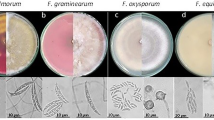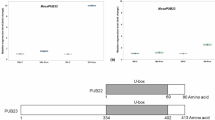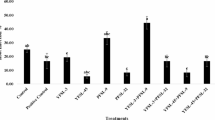Abstract
MANY phytopathogenic fungi must breach the intact plant cuticle to successfully invade and colonize their hosts. It has been suggested that cutinase, an extracellular enzyme secreted by many fungi, is essential for infection in some host–pathogen interactions. Chemical or immunological inhibition of cutinase protects the host from infection1, 2. We have cloned and characterized the cutinase complementary DNA and gene from Fusarium solani f. sp. pisi3, 4, a pea pathogen. A construct containing the cutinase coding region and extensive portions of the 5′ and 3′-flanking regions from theFusarium genome was transferred into another phytopathogenic Ascomycete, Mycosphaerella spp., a parasitic fungus that affects papaya fruits only if the fruit skin is mechanically breached before inoculation5. Here we describe the introduction of the Fusarium cutinase gene into Mycosphaerella to yield transformants in which this gene is inducible by cutin hydrolysate. We demonstrate that these transformants of the wound-requiring fungus have the capacity to infect intact papaya fruits, and that this infection can be prevented by antibodies against Fusarium cutinase.
This is a preview of subscription content, access via your institution
Access options
Subscribe to this journal
Receive 51 print issues and online access
$199.00 per year
only $3.90 per issue
Buy this article
- Purchase on SpringerLink
- Instant access to full article PDF
Prices may be subject to local taxes which are calculated during checkout
Similar content being viewed by others
References
Maiti, I. & Kolattukudy, P. E. Science 205, 507–508 (1979).
Kolattukudy, P. E. A. Rev. Phytopath. 23, 223–250 (1985).
Soliday, C. L., Flurkey, W. H., Okita, T. W. & Kolattukudy, P. E. Proc. natn. Acad. Sci. U.S.A. 81, 3939–3943 (1986).
Soliday, C. L., Dickman, M. B. & Kolattukudy, P. E. J. Bact. 171, 1942–1951 (1989).
Dickman, M. B., Patil, S. S. & Kolattukudy, P. E. Physiol. Plant Pathol. 20, 333–347 (1982).
Kolattukudy, P. E. Science 208, 990–1000 (1980).
Woloshuk, C. P. & Kolattukudy, P. E. Proc. natn. Acad. Sci. U.S.A. 83, 1704–1708 (1986).
Dhawale, S. S., Paietta, J. V. & Marzluf, G. A. Curr. Genet. 8, 70–79 (1984).
Kaster, R. K., Burgett, S. G. & Ingolia, T. D. Curr. Genet. 8, 353–358 (1984).
Turgeon, B. G., Garber, R. C. & Yoder, O. C. Molec. cell. Biol. 7, 3297–3305 (1987).
Lin, T. S. & Kolattukudy, P. E. J. Bact. 133, 942–951 (1978).
Podila, G. K., Dickman, M. B. & Kolattukudy, P. E. Science 242, 922–925 (1988).
Kolattukudy, P. E., Podila, G. K. & Mohan, R. Genome 31, 342–349 (1989).
Walton, T. J. & Kolattukudy, P. E. Biochemistry 11, 1885–1897 (1972).
Ptashne, M. Sci. Am. 260, 40–47 (1989).
Cathala, G. et al. DNA 2, 329–335 (1983).
Author information
Authors and Affiliations
Rights and permissions
About this article
Cite this article
Dickman, M., Podila, G. & Kolattukudy, P. Insertion of cutinase gene into a wound pathogen enables it to infect intact host. Nature 342, 446–448 (1989). https://doi.org/10.1038/342446a0
Received:
Accepted:
Published:
Issue date:
DOI: https://doi.org/10.1038/342446a0
This article is cited by
-
CglCUT1 gene required for cutinase activity and pathogenicity of Colletotrichum gloeosporioides causing anthracnose of Camellia oleifera
European Journal of Plant Pathology (2017)
-
What does it take to be a plant pathogen: genomic insights from Streptomyces species
Antonie van Leeuwenhoek (2010)
-
Structural and functional profile of the carbohydrate esterase gene complement in Phytophthora infestans
Current Genetics (2010)
-
Purification and identification of cutinases from Colletotrichum kahawae and Colletotrichum gloeosporioides
Applied Microbiology and Biotechnology (2007)
-
Genetic transformation of Ascochyta rabiei using Agrobacterium-mediated transformation
Current Genetics (2006)



